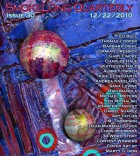Andrea, There’s so much to like in your story, “About things that are lost and the places that things get lost,” language, specificity, universality, the way you’ve used the idea of a “room” to eventually introduce “vagina;” the way you use the “relativity,” that both shrink and expand; the parallel items lost, how the keys, notes, cellular phone are to the room what condom, tampon, penis/baby are to the vagina. The story’s structure and your apparent awareness of and purposeful use of structure supply this story’s engine. Now I say “purposeful,” but there’s my question. How do you work with structure? How much of this comes from the moment of writing? How much do you go back and rework to make everything balanced and clear?
Thank you, Gay! I’m actually kind of obsessed with structure. Structure and imagery in equal amounts, I think, which can be very helpful in the short form and in poetry, but stunts me quite a bit when trying to extrapolate longer stories or plots, so there’s a real trade off. Part of it comes from a neurosis-ridden approach that I take, in that I won’t sit down to write a story out unless I have a very clear idea of exactly what happens, why it happens, and how I want to present it, and which themes are the ones I want to obsess on (and want everyone reading to obsess on). This means that I have an easier time building themes out and presenting them in a granular way, layering images, that sort of stuff, but I can also spend months and months drawing language, sentences and structure out in my head before sitting down at a computer. I’ve worked on stories that have taken multiple years to write, but only about 8 hours of actual keyboard work. I rarely go back to rework structure or language; most of my editing is done in the way of straight cuts to the text.
Structure is often the most vital part of a good story or what helps the writer FIND a good story, but not always so easy to do. You mention imagery. I’d love to hear more about that. How do you do it so that it is subtle, yet evocative?
My first love is poetry, and my second love is fairy tales and magical realism. That’s where I really started out, in forms that (in my view, anyway) are primarily reliant on language play and really lush imagery that serves to provide meaning to the story. I’ve since moved away from those forms toward short stories that are more “reality based,” or are at least less obtuse, mostly from a desire to confront the themes I’m working with head-on, instead of in an esoteric or roundabout fashion. I want people to read what I’ve written and immediately connect. But the emphasis on language and imagery hasn’t left; I just really work hard to incorporate it into settings and stories that come from “real life.” I feel like I’m using quotes excessively here instead of clarifying what I mean by real. I accept that.
“Reality” is up for personal interpretation. That’s why literature in whatever form has such a vast appeal. Theme or “purpose” has moved you from other genes to that of short fiction. Is short fiction enough or do you see longer work in your future?
I really want to write a novel. I’m moving farther and farther away from more experimental forms, for whatever reasons, probably more to do with life changes and how I see the world, and my comfort level in confronting my fear directly, more than anything else. But that neurosis that I mentioned earlier, as well as time constraints make it tough. I also have a tendency to work on multiple projects at the same time. For example, right now I’m working on three short stories, two novellas and a prose collection, as well as a graphic flash fiction collaborative with Cami Park, Donora Hillard, Laura Ellen Scott and Erin Fitzgerald. I need to learn how to be more focused if I’m ever going to actually accomplish anything of a significant length. But it’s a definite goal. I want to move toward longer, more plot based work.
You’ll write the novel when you’re ready. Sometimes we have to circle our goals before we come in for a landing. Your collaborative graphic flash fiction project sounds intriguing. Do you mind sharing more about that?
Sure. It’s in early stages; we are just beginning to produce the material for it. The concept is that each author will contribute about 5 very short, very dark fiction (around 500 words each). Think zombies, child murders, BP oil. I don’t want to say horror, but I want to say things that most people wouldn’t want to be stuck in an elevator with. Each of these stories will be illustrated. We’re still completing our short list/wish list of the artists we’d like to have involved. I think it’s going to be really great, but I’m biased, obviously. Mostly, I’m excited because I love graphic fiction, and I love having the chance to collaborate with talented writers. So much of writing is done in isolation, so to have the opportunity to work with a group like this on a shared concept is something really special, I think.
Good luck on such a fun and enriching project. So, last question. If you had one piece of advice to give someone who was just beginning to write seriously, what would you tell her?
Try not to get hung up on whether or not there is actually any point to what you’re doing.



 The core workshop of SmokeLong Fitness is all in writing, so you can take part from anywhere at anytime. We are excited about creating a supportive, consistent and structured environment for flash writers to work on their craft in a community. We are thrilled and proud to say that our workshop participants have won, placed, or been listed in every major flash competition. Community works.
The core workshop of SmokeLong Fitness is all in writing, so you can take part from anywhere at anytime. We are excited about creating a supportive, consistent and structured environment for flash writers to work on their craft in a community. We are thrilled and proud to say that our workshop participants have won, placed, or been listed in every major flash competition. Community works.